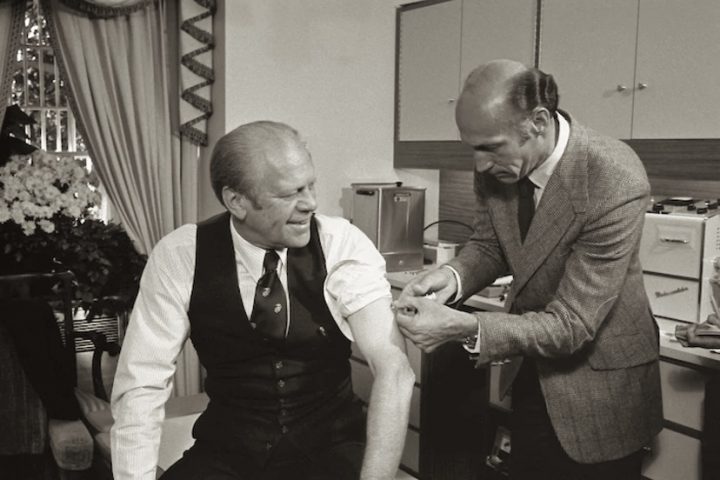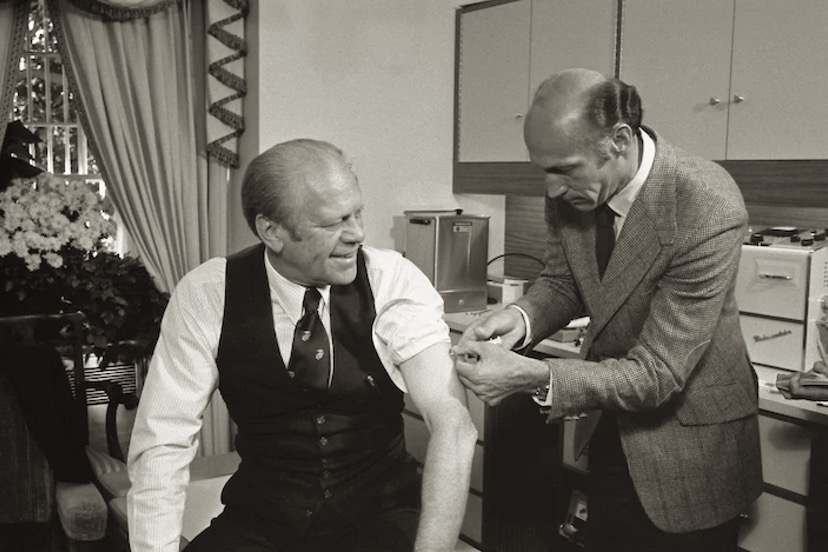Asked who is in charge of the effort, Trump said he is.
“I think probably, more than anything, I’m in charge. And I’m the one that gets blamed. And I get blamed anyway,” Trump said. “Don’t forget, if we come up with a vaccine in record time, they’ll say I should have done it faster. But we have a lot of good… a lot of good possibilities.”
— from “Administration describes a dash for a coronavirus vaccine that would be available in January”, by reporters Anne Gearan, Felicia Sonmez and Erica Werner in the Washington Post, April 30, 2020
Earlier in this editorial series, we briefly discussed the ineffective and unnecessary ‘National Influenza Immunization Program’ (NIIP) staged by the federal government in 1976, in response to a misdiagnosed health emergency. About 45 million Americans received a poorly-tested influenza vaccination for a minimally-contagious strain of flu that turned out to have mild symptoms. Government leaders, including President Gerald Ford, apparently feared the disease was similar to the H1N1 virus responsible for the deadly 1918 flu pandemic that killed perhaps 100 million people globally, but the 1976 flu never became a pandemic — nor even made an appearance outside the US. As far as I can tell from my limited research, only one person is known to have died after contracting the virus: an Army soldier stationed at Fort Dix in New Jersey, who collapsed following a forced 5-mile march.
But, apparently, hundreds died or were injured by the subsequent vaccine. From the 2006 essay, “Reflections on the 1976 Swine Flu Vaccination Program”, by David J. Sencer (Director of the Centers for Disease Control during the NIIP fiasco) and J. Donald Millar:
While all decisions related to NIIP had been reached in public sessions… effective communication from scientifically qualified persons was lacking, and the perception prevailed that the program was motivated by politics rather than science. In retrospect (and to some observers at the time), the president’s highly visible convened meeting and subsequent press conference, which included pictures of his being immunized, were mistakes. These instances seemed to underline the suspicion that the program was politically motivated, rather than a public health response to a possible catastrophe.
We might note that the failed NIIP vaccine program took place in 1976, the year that President Gerald Ford was running against challenger Jimmy Carter. Ford lost the election.

Sencer and Millar continued:
For policy decisions and in communication, making clear what is not known is as important as stating what is known. When assumptions are made, the basis for the assumptions and the uncertainties surrounding them should be communicated. This goal is much better accomplished if the explanations are communicated by those closest to the problem, who can give authoritative scientific information. Scientific information coming from a nonscientific political figure is likely to encourage skepticism, not enthusiasm.
What NIIP did not, and could not survive, however, was the the heightened incidence of Guillain-Barré syndrome among persons receiving swine flu immunizations. Guillain–Barré syndrome (GBS) is a rapid-onset muscle weakness caused by autoimmune damage to the nervous system. The initial symptoms are, typically, changes in sensation or pain, along with muscle weakness, beginning in the feet and hands, often spreading to the arms and upper body, with both sides of the body involved.The symptoms may develop over hours to a few weeks. In 1976, the list of possible causes of GBS included viral infections, injections, and “being struck by lightning.”
When cases of GBS were identified among recipients of the swine flu vaccines, they were well documented by the press. Because GBS cases are normally present in the population, the public health questions asked were: “Is the number of cases of GBS among vaccine recipients higher than would be expected? And if so, are the increased cases the result of increased surveillance, or a true increase?” The consensus, based on careful surveillance of the swine flu vaccine recipients, was that the new vaccine was causing GBS.
In 2006, Richard Krause — who had served as Anthony Fauci’s predecessor as director at the National Institute of Allergy and Infectious Diseases (NIAID) during the swine flu fiasco — wrote a short memoir about the 1976 events. Among his conclusions:
After much consultation and discussion at the highest levels of the US government, the Public Health Service launched a program to immunize 50 million people. Following the largest voluntary mass vaccination campaign since the mass vaccination programs with Salk and Sabin polio vaccines, nearly 25% of the US population, or 45 million persons, were vaccinated by October, 10 short months after the alarm was sounded.
The epidemic, however, did not occur. The Fort Dix outbreak was a false alarm, and the American public and much of the scientific community accused us of overreacting. As someone noted, 1976 was the first time we had been blamed for an epidemic that did not take place.
The 2020 COVID pandemic, meanwhile, is not a false alarm. In a matter of three short months, here in the US, the coronavirus is alleged to have killed more Americans (66,000) than were killed in the decade-long Vietnam War (58,220). Around the globe, it is alleged to have killed 246,000 people.
But the current rush to produce mass quantities of a poorly-tested vaccine should certainly remind us of the 1976 National Influenza Immunization Program, which produced an ineffective and apparently harmful vaccine within just 6 months of Congressional authorization. As much as the Trump administration might like to believe they will be helping produce a COVID-19 vaccine “in record time” — it would appear that the Ford administration holds a record that will be hard to beat. The value of such a record is unclear.

